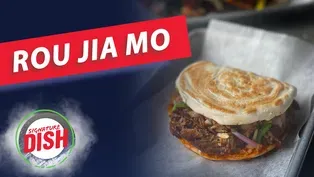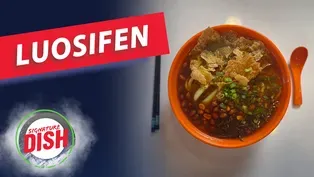Signature Dish
How Queen's English Puts a Twist on a Cantonese Red Snapper
Clip: Season 2 Episode 8 | 6m 40sVideo has Closed Captions
A standout crispy whole red snapper at Queen’s English in Columbia Heights.
Seth Tillman samples a standout crispy whole red snapper at Queen’s English in Columbia Heights. Chef and co-owner Henji Cheung de-bones the fish and then coats it in a light breading mixture of rice flour, cornstarch, and spices. As the fish fries, Henji prepares the chili sauce in the smoking hot wok, using lemongrass, red bell pepper, ginger, and garlic.
Problems with Closed Captions? Closed Captioning Feedback
Problems with Closed Captions? Closed Captioning Feedback
Signature Dish is a local public television program presented by WETA
Signature Dish
How Queen's English Puts a Twist on a Cantonese Red Snapper
Clip: Season 2 Episode 8 | 6m 40sVideo has Closed Captions
Seth Tillman samples a standout crispy whole red snapper at Queen’s English in Columbia Heights. Chef and co-owner Henji Cheung de-bones the fish and then coats it in a light breading mixture of rice flour, cornstarch, and spices. As the fish fries, Henji prepares the chili sauce in the smoking hot wok, using lemongrass, red bell pepper, ginger, and garlic.
Problems with Closed Captions? Closed Captioning Feedback
How to Watch Signature Dish
Signature Dish is available to stream on pbs.org and the free PBS App, available on iPhone, Apple TV, Android TV, Android smartphones, Amazon Fire TV, Amazon Fire Tablet, Roku, Samsung Smart TV, and Vizio.
Providing Support for PBS.org
Learn Moreabout PBS online sponsorshipHENJI: Today we're going to do a crispy red snapper, whole red snapper, with a Hong Kong chili sauce.
It's our play on a classic Cantonese steamed fish but with a modern twist to it.
We're going to start by just getting our salad ready.
That's going to be our garnish and it'll also lighten up the fish because it is a crispy fried fish.
We have a little mixed greens here, very simple.
We have a Thai basil, just some little herb freshness that goes in there.
And some shaved fennel, which gives a little crispy texture.
Little Maldon salt, little fresh ground pepper, and some extra virgin olive oil.
And that is the salad and garnish for the fish.
We're going to put that to side and now we're going to focus our attention to the red snapper.
SETH: All right.
And I feel like every time I get whole fish, whether it's fried, steamed, 90% of the time it's red snapper.
Why does it work so well?
HENJI: Snapper, it's just a great frying fish.
It's not too fatty, it's not too lean, you know.
It just has the right amount of meat and fat where it just fries up really well.
Our fish, our red snapper here, is completely de-boned.
We take all the bones out down the middle.
We leave the spine bone on just for presentation and for ease of frying.
SETH: I was going to say, it's going to make it a lot easier to eat when we're at the table.
HENJI: It is.
SETH: I think a lot of times people are just intimidated, myself included when you have to navigate all the uh, all the bones on the inside.
HENJI: Correct.
So that's typically in Cantonese cuisine, we eat our fish whole on the bone, you know, we steam it whole.
Obviously, it's a little bit different restaurant here, so it de-bone it.
It makes it easy for our guests.
Honestly, it makes it easy for our staff so they don't have to clean up the mess.
So we put the skewer across the fish and then we put another one through the tail into the head.
So this does two things.
One, for the obvious, is the presentation, and two, it fries evenly since if it wasn't skewered, it's just too thick of a fish and the insides raw, the outside's cooked, and then you wind up with a dry piece of snapper.
SETH: Well, we definitely don't want that.
So no batter, just breading?
HENJI: No batter, just breading.
In here, we've got rice flour, cornstarch, cumin, garlic, and onion powder.
We want the coating to be light because we still want the skin and the fins to get crispy.
You know, one of the greatest thing about this dish for me personally is eat the tail.
SETH: Eat the tail?
HENJI: All the spice, all the crunch on the tail is like the best Ruffle potato chips you ever have.
SETH: I'm ready to try it.
HENJI: So we have the spice mix on, so when you grab that salad, I'll grab this fish, we'll head over to the fire and we'll finish this dish.
SETH: Let's do it.
All right.
Chef, is it just me or is this just an absolutely enormous wok?
HENJI: This is a massive wok, and also with massive firepower.
A normal stove is about 20,000 BTU.
We have 175,000 BTU here.
SETH: Oh my goodness.
And what do you get with all that extra power?
HENJI: So in Cantonese cuisine, we have something called wok hei or the breath of the dragon.
So with all that firepower, that will give us the true breath of the dragon.
SETH: All that hot, fast cooking is going to also help with the texture, get a nice little char on the outside of everything?
HENJI: Correct.
SETH: So you're going to get this thing fired up?
HENJI: Yeah.
So we're going to start.
So simply, we just put the fish in the fryer.
We hold it down and start our timer.
While the fish is frying, we're going to turn on the wok, get it hot, add our oil.
So now the wok is smoking.
We're going to add in our Napa cabbage and add in our garlic.
You can feel the heat already.
And we're just going to roast that a little bit.
The good thing about the wok is because it's such high heat, you get a good char without overcooking the vegetable.
So we're going to lower the flame a little bit.
This is where we add in our sauce.
So this is our Hong Kong chili sauce.
It's got lemongrass, red bell pepper.
We do a ginger and garlic gastrique.
We add our sesame oil, confit garlic back in there.
And that's the sauce.
SETH: You can't even see what's happening in this thing, there's so much steam.
HENJI: You can't.
You kind of just got to listen to the sizzle.
SETH: Just pure muscle memory from doing this.
HENJI: Pure muscle memory, just by sound and smell.
The crab butter goes in so that gives a little bit of richness to the sauce.
(beeping) SETH: All right, timer went off.
That was fast.
HENJI: Timer went off.
Yep.
We drain off the excess oil.
We lay the fish on the tray.
We're going to leave the fish there.
We're going to grab our plate.
We're going to put the sauce on the plate, and then we're going to put the fish on top of that.
SETH: So the fish will stay nice and crispy?
HENJI: Correct.
SETH: All right.
I like that.
HENJI: Now we just make sure our salad is nice and dressed and tossed one more time.
We're going to garnish it with the salad.
And here is our crispy red snapper.
SETH: Chef, that was a spectacular cooking process and a spectacular-looking dish.
I can't wait to try it.
HENJI: I can't wait for us to eat it as well.
SETH: All right, the whole fish, salad on top.
What's the best plan of attack?
SARAH: I would take all the salad, put it to the side, get to the good stuff.
The fish is mostly deboned, but the tail and the two fins on the side, you're definitely going to want to put to the side and enjoy it at the very last.
SETH: All right, I'm going to start with... SARAH: With your chips.
SETH: Just a little bit of meat right here.
And I have to ask, what pairs nicely with this beautiful crispy red snapper?
SARAH: Honestly, I think the perfect pairing is The Queen.
It's an orange wine that we make with a friend of ours, Kim McPherson in West Texas.
SETH: This is an orange wine?
SARAH: It's an orange wine.
It's two weeks on the skin.
It just has this really fun, pineapple kind of like, peach fruity flavor.
Nothing nuanced, so it definitely holds up to all the flavor in the sauce.
SETH: Cheers to that.
SARAH: Cheers.
HENJI: Cheers.
SETH: Nice and refreshing.
SARAH: Yes.
SETH: All right, I'm digging in here.
Mmm.
Wow.
That is exquisite.
That fish is so flaky and tender.
Everything balances so nicely.
I'm going to try it with a salad as well.
Still getting that crispiness and crunchiness from the cabbage, some of that lightness from the salad.
And the sauce, I just can't get enough of that sauce.
HENJI: Yeah, that's definitely the best part of the dish.
SETH: And this is a traditional Hong Kong-style chili sauce?
HENJI: It's definitely our interpretation of it.
It's uh, it's more like a play between a sweet chili and a spicy chili sauce where it's kind of in the middle.
SETH: So it kind of goes to that idea of just sort of whatever works, you know, you're not uh, bound by any specific traditions?
HENJI: No, not really.
It's uh, the foundation of the cuisine is always Cantonese flavor profile.
But besides that, you know, we just have fun cooking what we like to cook.
Host Seth Tillman takes a flavorful journey through Chinese cuisine in DC, MD and VA. (30s)
Rou Jia Mo -- a Chinese Burger -- at Northwest Chinese Food
Video has Closed Captions
Rou jia mo (Chinese hamburger) at Northwest Chinese Food in College Park, MD. (5m 55s)
Snail-Flavored Chinese Noodles at Yanzi Noodle House
Video has Closed Captions
A noodle soup flavored with snails at Yanzi Noodle House in Fairfax, VA. (5m 11s)
Providing Support for PBS.org
Learn Moreabout PBS online sponsorshipSupport for PBS provided by:
Signature Dish is a local public television program presented by WETA














